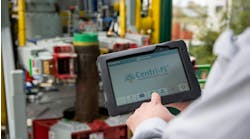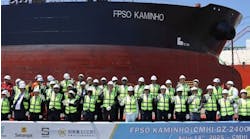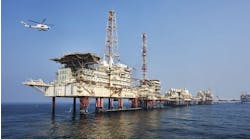William Furlow
Houston
Ceramic membrane key to syngas process
According to the US Department of Energy, about 60% of the capital costs of the Fischer-Tropsch process go into syngas production. The bulk of this is spent on air separation necessary to produce a pure oxygen stream. Ceramic membranes may represent an enhanced technology for syngas production. Such membranes allow the air separation and syngas plants to be combined into one process unit. The DOE and Air Products and Chemicals are taking the next step in this technological advancement with the development of ceramic membranes for application in the gas-to-liquids process. This innovative technology could reduce the cost of producing syngas by 25%.The key challenges to designing this system are designing and synthesizing a membrane that will withstand the rigors of the syngas production process. The membrane material must stand up to high pressures, be stable in both reducing and oxidizing atmospheres, and must be compatible with the catalysts used in the process, according to Doug Bennett general manager of advanced gas separation for Air Products and Chemical.
First open-hole sand screen installed
Petroline Wellsystems, of Scotland, reports it has installed the first open-hole expandable sand screen in a well for Shell in the southern North Sea. This screen can be run down wells in pre-formed condition and then expanded by a cone-shaped mandrel to produce a tight fit with the formation wall. Expandable connections allow any length of screen to be run.In addition to the field trials, the screen system was laboratory tested with the filtration materials as well as full mechanical testing of other components. The system offers an advantage over traditional gravel packing systems and screens. According to Petroline Product Manager Calum Whitelaw, gravel packs can be expensive to install and can limit production, while sand screens are prone to plugging and failure. The objective of the Petroline screen is to expand against the bore hole, provide support, and reduce sand movement, fines migration, and associated plugging. The system can be installed in about the same time as a conventional screen system and for about the same price.
Shaffer BOP includes remote change-out
Shaffer's new NXT blowout preventer (BOP), introduced at the Offshore Northern Seas conference in Stavanger, Norway, features hydraulically-operated door controls and incorporates the spherical packer unit with the ram preventers. This provides for savings in weight and space. The BOP also features what the company is calling the "world's first" automated ram changer.The boltless door assembly allows the doors to be operated hydraulically or by remote, allowing the automated ram changer to make ram configuration changes, via a deepwater remotely operated vehicle (ROV), on the sea floor. This eliminates the need to trip the stack ever time a configuration change is required.
Pneumatic actuator has reverse action
Baker Oil Tools has developed a fail-safe pneumatic actuator to ensure well control without the added cost of additional features. The PneuMaster actuator is used to open and close a reverse-acting or direct-acting gate valve through pneumatic pressure applied to a closed cylinder. Fail-safe return occurs through a coil spring that provides a return stroke in the absence of flowline pressure.Baker has applied its spring-energized, non-elastomeric technology to developing an actuator for use with the Gate Master Hydraulic Actuator. The PneuMaster is designed to complement the GateMaster Hydraulic Actuator and is designed for applications where the patented Quick Disconnect or other features in the standard actuator line are not required. The Master Series of actuators contains a non-elastomeric bonnet stem packing unit. The packing covers the entire range of temperature ratings and eliminates the concerns of different services. Other features prevent damage to seals from debris, blowout protection in event of fire, and elimination of the need for disassembly to set valve drift.
ABB takes next step with seafloor separation
ABB Oil, Gas and Petrochemicals has introduced its Subsea Injection and Separation System (SUBSIS) to separate water from oil and gas on the ocean floor at depths of up to 2,000 meters. The system removes bulk water from the well stream. This water is either treated and released to the sea or reinjected into the formation. The system is capable of two, three, or four stage separation. It can route gas and oil phases to different infrastructures, and route the water phase to different locations on the infrastructure.There are five major technologies involved in the Subsis. The subsea electrical power distribution system, boosting and injection system, separation technology, control and monitoring, and subsea intervention. Norsk Hydro has selected this system for the Troll C field where the water and oil will be separated subsea and the water reinjected.
Halliburton launches new MWD tool
According to Halliburton, the StrataTracker (TM) is the industry's first slimhole, at-bit inclination and scanning azimuthal gamma tool. The unit will debut in a 4-3/4-in. size with a 6-3/4-in. tool to follow later this year. The tool's 11-in. measurement from the bit, consists of static and dynamic inclination, total and azimuthal gamma ray, and motor RPM. The azimuthal gamma ray measurement is a scanning measurement focused to detect the "hot side" of the borehole for the delineation of bed boundaries - a dynamic measurement made while rotating the drillstring or sliding.With existing technology, azimuthal gamma measurements can be obtained only when drilling operations have ceased and the tool manually oriented. This manual tool orientation delays the drilling operation and creates the opportunity for unintentional sidetracking of the well.
The sensor measurements are processed before being transmitted via "short-hop" to a separate module located in the bottom hole assembly above the motor. The transmission is an electromagnetic induction method designed to operate in all mud types, including oil-based muds and in low and high resistivity formations. The upper module connects with the firm's PathFinderTM High-Speed Directional Survey tool for real-time transmission to the surface. When necessary, a quad combo string consisting of deep-reading resistivity, density, porosity, and sonic tools can also be run for a more thorough real-time analysis of the formation.
Copyright 1998 Oil & Gas Journal. All Rights Reserved.


